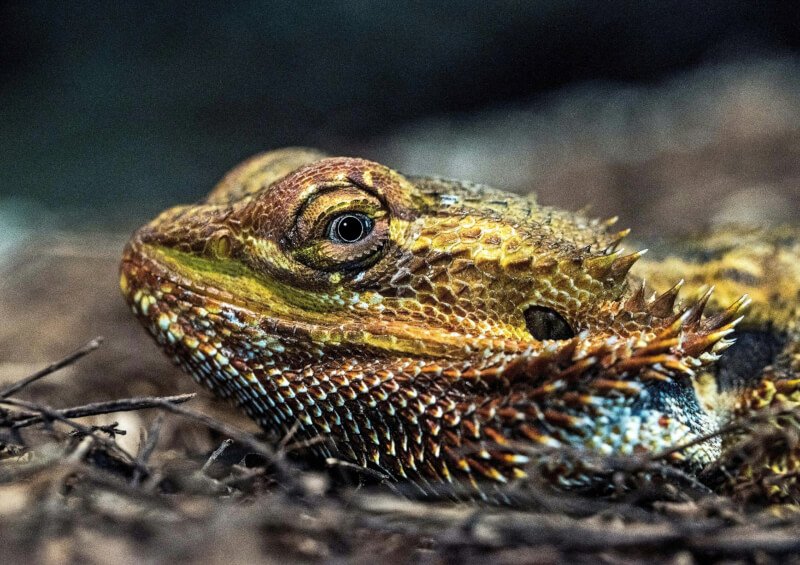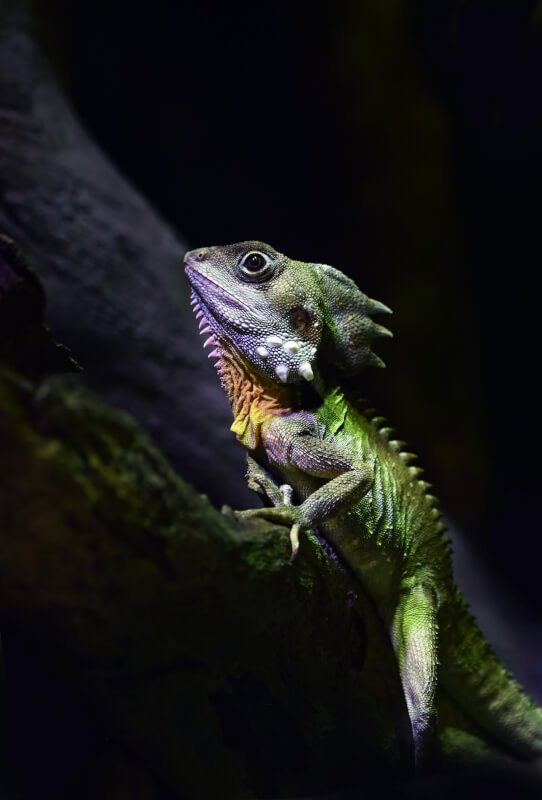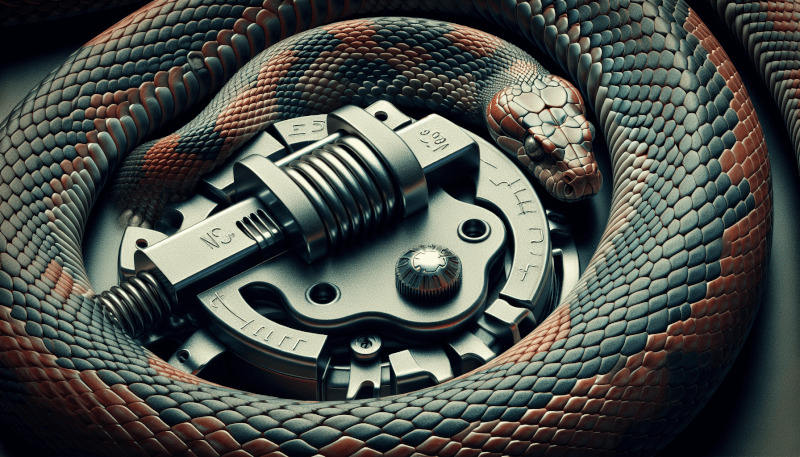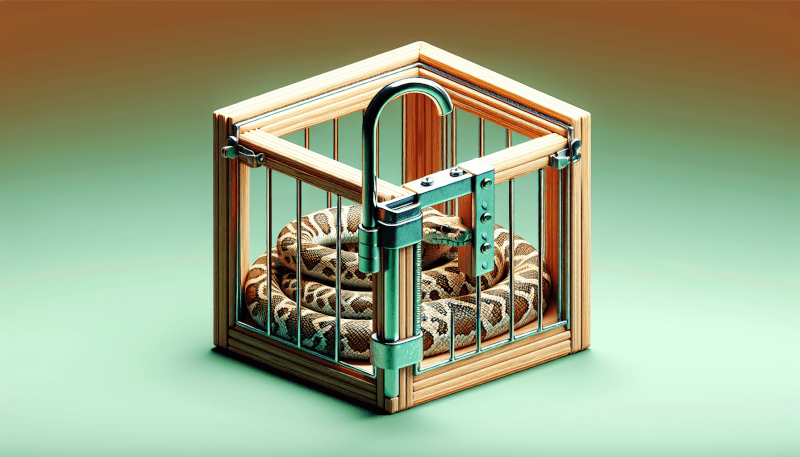Building a safe and secure habitat for your beloved reptile companion can be both an exciting and challenging endeavor. In this article, you will discover the essential steps to creating a predator-proof snake enclosure. Whether you are a passionate hobbyist or a dedicated snake owner, these guidelines will provide you with the necessary knowledge to ensure the utmost protection for your slithering friend. From selecting the right materials to implementing effective security measures, this article will guide you through the process of creating an enclosure that offers the perfect blend of comfort and safety for your snake.

Designing the Enclosure
Designing the enclosure for your snake is an essential step in creating a safe and comfortable habitat for your reptile friend. To begin, you’ll need to determine the species of snake you’ll be housing. Different snake species have varying needs in terms of space, temperature, and humidity, so it’s important to research the specific requirements of your chosen species.
Once you have determined the snake species, you can move on to choosing the right size for the enclosure. The size will depend on the size of your snake and its natural behavior. Snakes that are more active and require more space will need larger enclosures, while smaller, less active species may do well in a smaller space. It’s crucial to provide enough room for your snake to move, stretch, and explore comfortably.
Selecting suitable materials for the enclosure is another important consideration. The material should be strong, durable, and easy to clean. Some common materials used for snake enclosures include glass, plastic, and wood. Each material has its pros and cons, so research the advantages and disadvantages of each before making a decision.
Creating a solid base for your snake enclosure is crucial for stability and security. The base should be sturdy enough to support the weight of the enclosure and your snake. Plywood or melamine boards are popular choices for the base as they provide stability and can be easily cleaned.
Next, designing the walls and roof of the enclosure is essential to prevent escape and protect your snake from potential predators. The walls should be tall enough to prevent your snake from climbing or slithering over them. The material used for the walls should also be secure and escape-proof.
Constructing the Enclosure
Once you have finalized the design of your snake enclosure, it’s time to start constructing it. The first step is to prepare the area where the enclosure will be placed. Clear any debris, level the ground if necessary, and ensure that the area is clean and secure.
Building a solid foundation is crucial to the stability of the enclosure. This can be achieved by using concrete or laying down gravel to create a level surface. Ensuring a stable foundation will prevent the enclosure from shifting or sinking over time.
After preparing the area and building a foundation, you can begin installing the walls and roof of the enclosure. Depending on the chosen material, you may need to cut and assemble the panels accordingly. Secure the panels tightly to prevent any gaps that could serve as an escape route for your snake.
Adding a door or entrance to the enclosure is necessary for easy access and maintenance. The door should be secure and properly sealed to prevent any potential escapes. Consider using locks or latches to ensure the door remains closed and your snake stays safe.
Sealing any gaps or openings in the enclosure is crucial to avoid any potential predators from entering and harming your snake. Inspect the walls, roof, and corners for any small openings or weak points. Seal these areas with appropriate materials to ensure the enclosure is escape-proof and predator-proof.

Ensuring Proper Ventilation
Proper ventilation is vital for maintaining a healthy environment within the snake enclosure. Good airflow helps in regulating temperature and removing excess humidity and odors. Without proper ventilation, the enclosure can become stagnant and potentially harmful to your snake’s health.
Ventilation holes should be incorporated into the design of the enclosure to allow for the exchange of air. These holes should be strategically placed to provide adequate airflow without compromising the security of the enclosure. Research the specific ventilation requirements of your snake species and consult with experts if needed.
Considering airflow and temperature control is crucial when designing the ventilation system. Place the ventilation holes strategically to ensure consistent airflow throughout the enclosure. This helps in maintaining an optimal temperature range and preventing the buildup of excessive heat or humidity.
Building the Snake-Proof Fence
In addition to the enclosure itself, constructing a snake-proof fence around the area adds an extra layer of security. This helps in preventing snakes from entering or escaping from the enclosure. There are a few key factors to consider when building this fence.
Choosing the right fencing material is important to ensure it is snake-proof. Metal mesh with small gaps is commonly used as it prevents snakes from passing through. Make sure the fencing material is strong and securely attached to provide maximum security for your snake.
Determining the fence height is crucial to prevent any snakes from climbing over it. The height will depend on the size and behavior of the snake species you are housing. Research the climbing abilities of the specific species and build the fence accordingly.
Securing the fence to the ground is essential to prevent snakes from digging underneath it. Burrowing is a common escape tactic for snakes, so ensure that the fencing extends sufficiently below the ground surface. This will thwart any attempts of the snake to escape through digging.
Inspecting the fence for any gaps or weak points is important to ensure its effectiveness. Regularly check the fence for any damages, such as holes, loose wires, or gaps, and promptly repair them. A well-maintained snake-proof fence will prevent any potential predators from gaining access to the enclosure.

Adding Security Measures
To further enhance the protection of your snake enclosure, it’s wise to consider adding security measures. These measures can help deter potential threats and ensure the safety of your snake.
Installing locks or latches on the enclosure’s doors adds an extra layer of security and prevents unauthorized access. Ensure that the locks or latches are of high quality and cannot be easily tampered with.
Implementing an alarm system is another effective security measure. This can alert you to any potential breaches or intrusions, allowing you to take immediate action. Choose an alarm system that is reliable, easy to install, and suited to your specific needs.
Using surveillance cameras can provide additional peace of mind, allowing you to monitor the enclosure remotely. This can be especially helpful when you’re away from home but still want to keep an eye on your snake’s well-being. Install the cameras in strategic locations to maximize their effectiveness.
Placing motion sensor lights around the enclosure helps deter potential predators and provides additional security during nighttime. These lights will detect any movement in the surrounding area and illuminate it, potentially scaring away any unwanted visitors.
Providing Adequate Lighting
Proper lighting is important for maintaining a healthy environment for your snake. Different snake species have varying lighting requirements, so it’s crucial to determine the specific needs of your snake and provide suitable lighting accordingly.
Start by determining the lighting requirements of your snake species. Some snakes require UVB lighting to meet their physiological needs, while others may require specific heat lamps or bulbs. Research the lighting needs of your snake and consult with experts if necessary.
Choosing the right light source is essential for creating a comfortable and stimulating environment. UVB lighting is necessary for snakes that require it, as it helps in the production of vitamin D and calcium absorption. Heat lamps or bulbs should also be chosen based on the specific temperature requirements of your snake.
Installing lighting fixtures in the enclosure should be done strategically. Position the fixtures to provide proper heat and light distribution throughout the enclosure. Ensure that the fixtures are securely installed and that the snake cannot come into direct contact with them.

Creating a Comfortable Habitat
In addition to security and proper lighting, it’s important to create a comfortable habitat within the enclosure for your snake. This includes providing suitable substrate or bedding, incorporating hiding spots, including climbing structures, and ensuring access to a water source.
Adding substrate or bedding to the enclosure mimics the snake’s natural habitat and provides a comfortable surface for them. Depending on the snake species, options for substrate include reptile bark, coconut fiber, or newspaper. Research the specific substrate needs for your snake and choose accordingly.
Incorporating hiding spots is crucial to make your snake feel secure and reduce stress. This can be achieved by adding caves, hollow logs, or other types of hiding spots within the enclosure. Provide multiple hiding spots throughout the enclosure to allow your snake to choose its preferred resting place.
Including climbing structures helps snakes exercise their natural behavior and adds enrichment to their habitat. This can be accomplished by adding branches, driftwood, or artificial vines that create vertical climbing opportunities. Ensure that the structures are stable and securely anchored to prevent any accidents.
Providing a water source within the enclosure is necessary for your snake’s hydration and overall health. Choose a suitable water dish or bowl that is easy to clean and large enough for your snake to comfortably soak if needed. Regularly clean and refill the water source to ensure cleanliness and freshness.
Maintaining the Enclosure
Regular maintenance of the snake enclosure is crucial to ensure the health and well-being of your snake. This includes regular inspection and cleaning, trimming vegetation around the enclosure, and monitoring for signs of predators.
Regularly inspecting the enclosure allows you to identify any potential issues or damages before they become major problems. Check for any broken or damaged parts, loose fittings, or signs of wear and tear. Promptly repair or replace any damaged components to maintain the integrity of the enclosure.
Cleaning the enclosure on a regular basis is essential to prevent the buildup of waste, bacteria, and parasites. Remove any waste and debris, clean the surfaces thoroughly, and disinfect the enclosure as recommended for your snake species. Pay special attention to areas that are prone to moisture or food buildup.
Trimming vegetation around the enclosure helps prevent potential predators, such as birds or larger reptiles, from using the vegetation as cover or direct access to the enclosure. Keep plants and shrubs well-maintained and at a safe distance from the enclosure to reduce the risk of predatory attacks.
Monitor the surroundings of the enclosure for any signs of potential predators, such as tracks or droppings. Take necessary steps to deter or eliminate any threats, such as securing the fence or implementing additional security measures.

Ensuring Proper Heating
Proper heating is essential to maintain the health and well-being of your snake. Different snake species have varying heat requirements, so it’s important to understand the specific needs of your snake and provide suitable heating options.
Understanding the heating needs of your snake is crucial. Some snakes require a specific temperature gradient within their enclosure to regulate their body temperature effectively. Research the specific temperature requirements for your snake species and create a suitable thermal gradient within the enclosure.
Using heat pads or heat lamps can provide the necessary heat source for your snake. Heat pads are placed under the enclosure and provide a gentle heat source, while heat lamps can mimic the warmth of the sun. Ensure that the heat source is regulated and monitored to avoid overheating or creating hot spots.
Monitoring the temperature and humidity levels within the enclosure is important to maintain a stable and comfortable environment for your snake. Use a reliable thermometer and hygrometer to regularly monitor these parameters, making necessary adjustments to ensure optimal conditions.
Educating Yourself about Snake Behavior
To provide the best care for your snake and ensure its safety, it’s essential to educate yourself about snake behavior. Understanding their habits, escape techniques, and potential risks will help you better anticipate and address any potential issues.
Studying snake habits will give you insight into their natural behavior and specific needs. Learn about their feeding habits, preferred hiding spots, and typical activity patterns. This knowledge will help you create a more suitable and enriching environment for your snake.
Learning about their escape techniques is crucial to prevent any potential escapes from the enclosure. Snakes are excellent escape artists and can exploit even the smallest gaps or weaknesses in the enclosure. By understanding their escape tendencies, you can take proactive measures to minimize the risk of escape.
Understanding potential risks associated with housing snakes will help you better protect your snake and create a safe environment. Research potential hazards, such as toxic plants, sharp objects, or harmful substances, and eliminate or mitigate these risks within the enclosure.
By following these comprehensive steps and guidelines, you can create a predator-proof snake enclosure that provides a safe and comfortable habitat for your beloved reptile companion. Remember to always prioritize the well-being and security of your snake and seek professional advice when needed.


